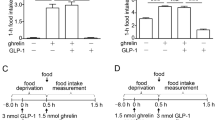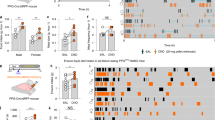Abstract
The pre-proglucagon derived peptides, glucagon-like peptide-1 (GLP-1) and glucagon-like peptide-2 (GLP-2) are both involved in a wide variety of peripheral functions, such as glucose homeostasis, gastric emptying, intestinal growth, insulin secretion as well as the regulation of food intake. Pre-proglucagon is also found in the brainstem in a small population of nerve cells in the nucleus of the solitary tract (NTS) that process the pre-propeptide as in the gut to yield GLP-1 and GLP-2. GLP-1 containing nerve fibres and the GLP-1 receptor are found predominantly in hypothalamic midline nuclei. GLP-1 given centrally to naive rats results in a marked induction of c-Fos protein in the supraoptic nucleus, paraventricular nucleus of the hypothalamus (PVN) and central nucleus of the amygdala, but only a moderate increase in the arcuate nucleus. The pattern of c-Fos activation is compatible with the appetite suppressing effects of GLP-1. This anorectic effect of GLP-1 appears to be mediated by the PVN, as direct injections of GLP-1 into this nucleus cause anorexia without concomitant taste aversion, suggesting a specific action upon neuronal circuits involved in the regulation of feeding. Recent experiments have also shown that GLP-1 is implicated in mediating signals from the gastrointestinal tract pertaining to discomfort and malaise. The distribution of the co-localised peptide, GLP-2, displays a perfect overlap with GLP-1 in the CNS with the highest concentration in the diffuse ventral part of the dorsomedial nucleus (DMHv). In contrast to the widely distributed GLP-1 receptor mRNA, GLP-2 receptor mRNA is exclusively expressed in the compact part of the DMH (DMHc). Interestingly, the DMHc is also the only nucleus responding to central administration of GLP-2 with a significant increase in the number of c-Fos positive cells. When injected into the lateral ventricle, GLP-2 has a marked inhibitory effect on feeding. The effect of GLP-2 on feeding is both behaviourally and pharmacologically specific. Future experiments will elucidate whether or not GLP-1 and GLP-2 are involved in the long-term or short-term regulation of feeding behaviour and hence have an impact on bodyweight.
This is a preview of subscription content, access via your institution
Access options
Subscribe to this journal
Receive 12 print issues and online access
$259.00 per year
only $21.58 per issue
Buy this article
- Purchase on Springer Link
- Instant access to full article PDF
Prices may be subject to local taxes which are calculated during checkout
Similar content being viewed by others
Author information
Authors and Affiliations
Corresponding author
Rights and permissions
About this article
Cite this article
Tang-Christensen, M., Vrang, N. & Larsen, P. Glucagon-like peptide containing pathways in the regulation of feeding behaviour. Int J Obes 25 (Suppl 5), S42–S47 (2001). https://doi.org/10.1038/sj.ijo.0801912
Published:
Issue Date:
DOI: https://doi.org/10.1038/sj.ijo.0801912
Keywords
This article is cited by
-
Single-Anastomosis Sleeve Jejunal Bypass, a Novel Bariatric Surgery, Versus Other Familiar Methods: Results of a 6-Month Follow-up—a Comparative Study
Obesity Surgery (2020)
-
Angptl8 mediates food-driven resetting of hepatic circadian clock in mice
Nature Communications (2019)
-
Mechanism of Glucagon-Like Peptide 1 Improvements in Type 2 Diabetes Mellitus and Obesity
Current Obesity Reports (2019)
-
Endocrine regulation of fueling by hyperphagia in migratory birds
Journal of Comparative Physiology A (2017)
-
Exenatide Add-on to Continuous Subcutaneous Insulin Infusion Therapy Reduces Bolus Insulin Doses in Patients with Type 2 Diabetes: A Randomized, Controlled, Open-Label Trial
Diabetes Therapy (2017)



